Rec Sports
‘PLAAAY BAAALL’ – Weston hits it out of the park with revival of community’s youth ball program – BG Independent News
By JAN McLAUGHLIN BG Independent News The ballplayers, dressed in their crisp clean uniforms, were bundles of energy. This was opening day at the Weston ballpark – and their town was celebrating the beginning of a summer spent watching their kids play ball. The revival of the Weston youth baseball, softball and T-ball has been […]

By JAN McLAUGHLIN
BG Independent News
The ballplayers, dressed in their crisp clean uniforms, were bundles of energy. This was opening day at the Weston ballpark – and their town was celebrating the beginning of a summer spent watching their kids play ball.
The revival of the Weston youth baseball, softball and T-ball has been led by a group of parents and grandparents committed to resurrecting the program that over the years had lost its spirit.
And on Saturday afternoon, the group hit a home run on opening day.
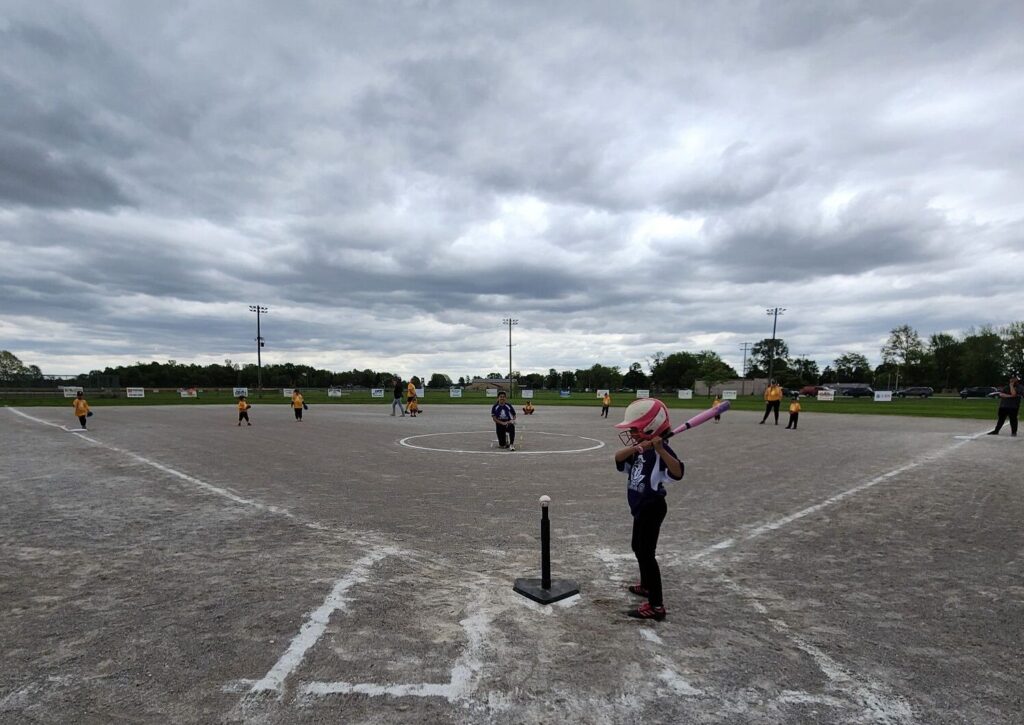
The festivities began with a parade of the ball teams, starting at the library downtown and traveling through neighborhoods to the ballpark. The young ballplayers cheered and chanted, as townspeople stood on their porches and front yards to celebrate the teams and the beginning of a new season.
A siren from the Wood County Sheriff’s vehicle leading the route announced the arrival of the antsy young players, and a Weston fire truck followed at the rear of the parade.
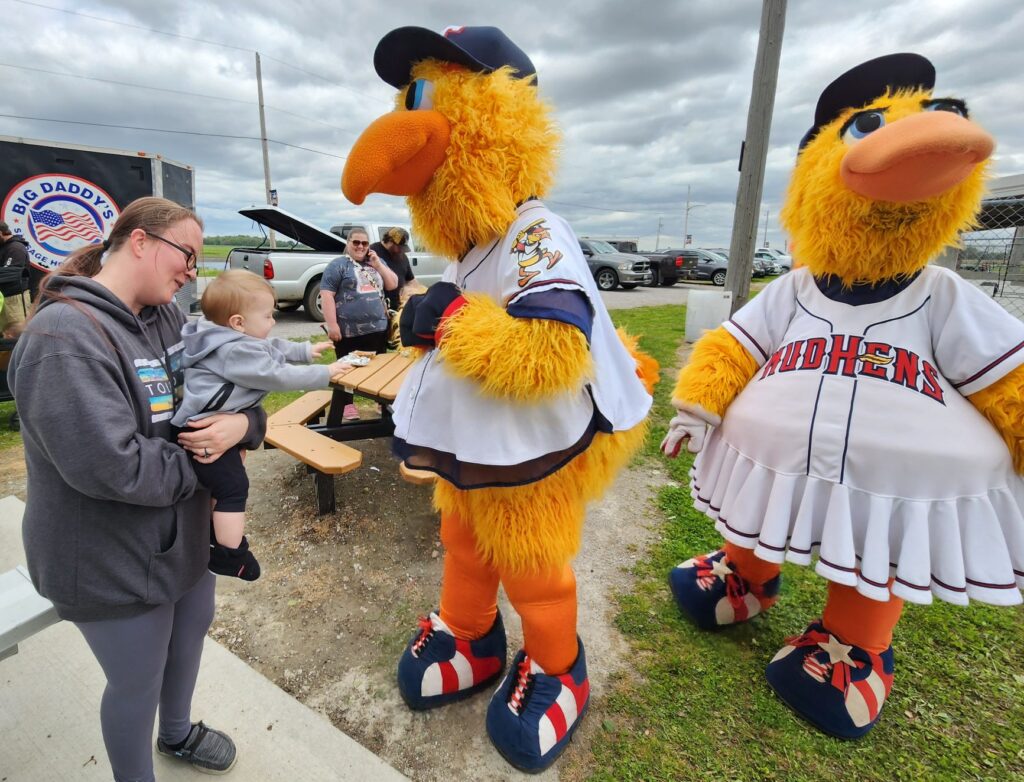
When the teams arrived at the ballpark, they were greeted by more townspeople ready to watch them do the ceremonial run around the bases, get team photos taken, and devour their first ballpark food of the season.
Jeanettie Zamarripa was one of the Weston residents determined to bring back the summer ball season. She coached her granddaughter’s team last year, and this year found herself as president of the Weston Sports Initiative Association.
“The program just needed to be picked up by people who cared about it,” Zamarripa said. The non-profit organization, run by passionate board members and volunteers, has seven teams this year. They compete against other community teams in the Otsego School District – Grand Rapids, Haskins and Tontogany.
The Village of Weston stepped up on the upkeep of the ballpark, Zamarripa said.
And after opening day Saturday, Zamarripa and others plan to spend much of their summer at the park – cheering from bleachers, coaching in the fields, monitoring kids in the dugouts.
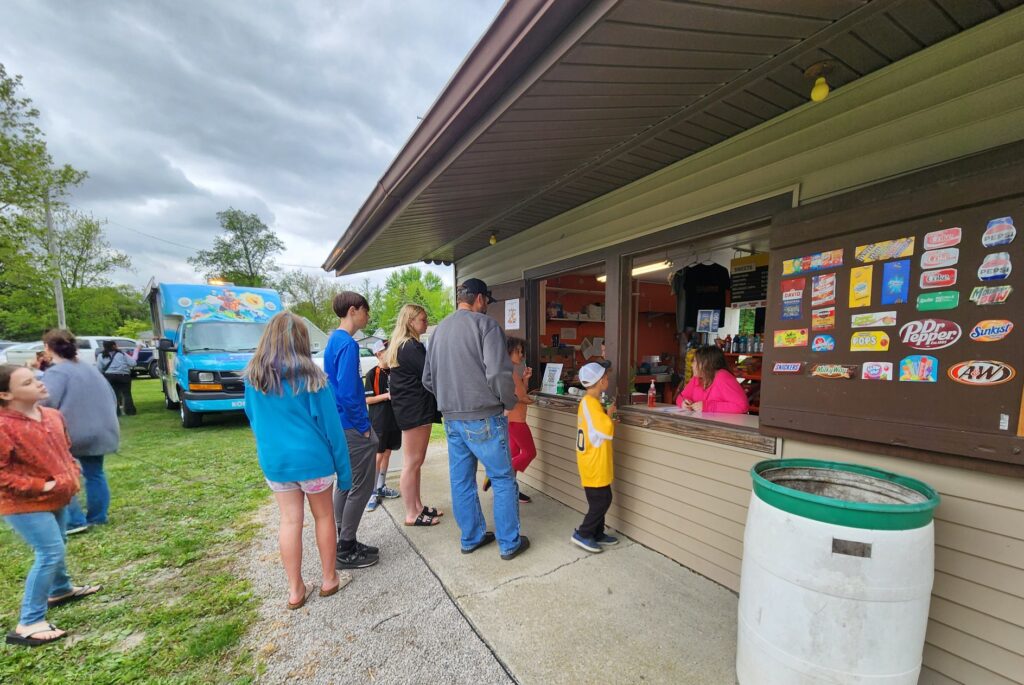
Saturday saw a steady line of fans and families at the concession stand, behind home plate. The big sellers on the first day of the season were typical ballpark foods – hotdogs, popcorn and pretzels.
Jessica Susor, a concession stand volunteer, said the familiar smells draw in customers.
“Everybody is always waiting for the hot buttered popcorn,” Susor said.
Along the third base line, the Kosicki T-ball team in their bright yellow uniforms, gathered around a picnic table. The players, just 4 to 6 years old, weren’t talking game strategy – they were wandering off to get snow cones, chasing each other, shrieking in delight at visits by the costumed Muddy and Madonna Mudhen and from Freddy and Frieda Falcon.
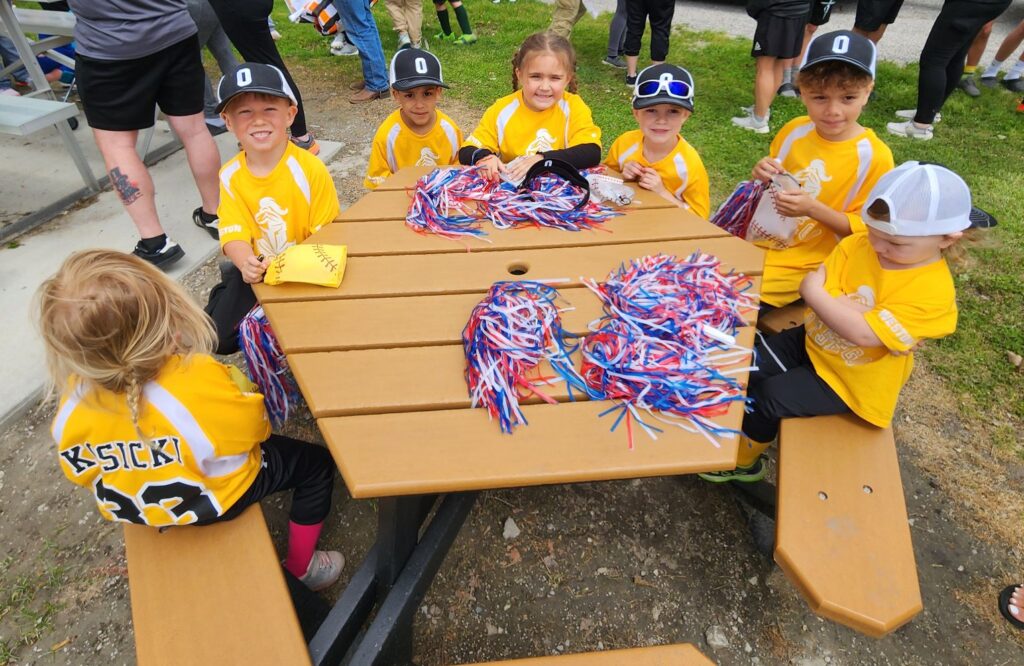
Their coaches took it all in stride. One parent described coaching a T-ball team like herding cats, but with a smile, coach Ashley Kosicki said it was more like “feral squirrels.”
Kosicki and parent Cheyenne Cheatwood talked about the importance of a summer ball program – even for kids too young to pick up many skills.
“It’s important to keep it alive for the small community,” Cheatwood said. “The kids get really excited.”
With a heavy dose of patience, Kosicki talked about the youngest players developing skills not necessary in the batter’s box or in the outfield.
“The mental health aspect is the most important thing for this age,” she said.
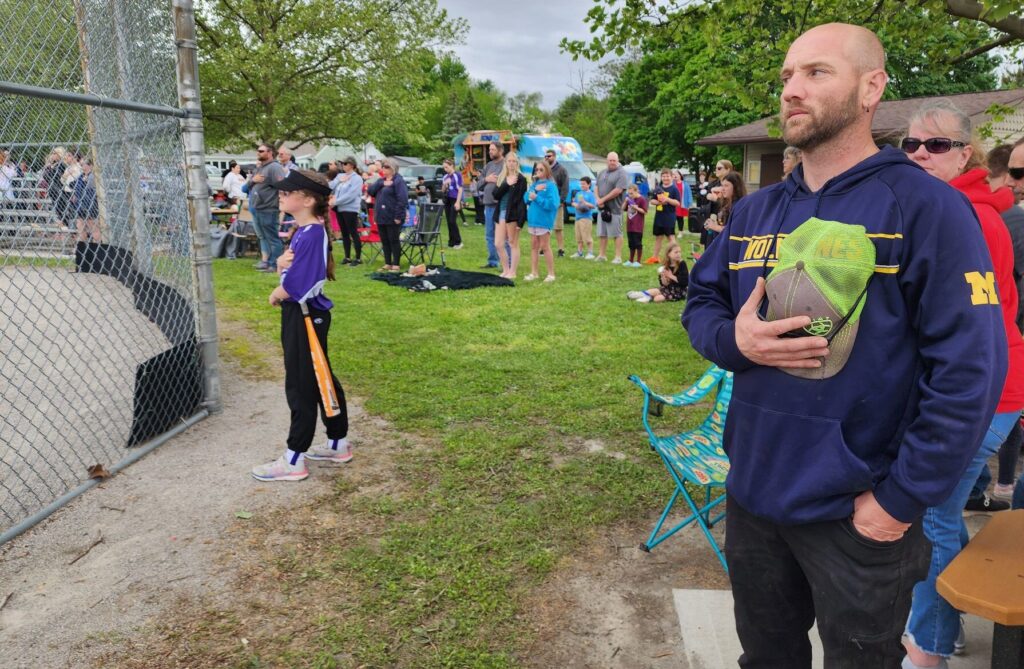
Before the games began, each team took a ceremonial run around the bases. James and Christina Fox sat on the bleachers and watched as their two sons, Colton and Wyatt, joined in the opening day tradition.
James Fox pointed out the more experienced players who faked falls as they came into home.
“They get a little dirt on them for the pictures,” he said, as one player rolled around in the gravel.
The Fox parents are thrilled their sons are outside playing ball, rather than inside playing video games, on their phones or their tablets.
“Our kids are all sports, sports, sports,” James Fox said.
Consequently, the parents will be spending many evenings at the ballpark. This coming week, that means rooting from the bleachers on Monday, Wednesday, Thursday and Saturday. “That’s the schedule this week for us,” the father said.

On the sidelines behind first base, players and coaches were lining up for team photos. The photographer repeated the instructions, “Hands down. Eyes up. Big smiles,” – hoping one of the shots would be good.
Meanwhile, girls with hair ribbons matching their uniforms, sat on the ground, drawing pictures in the gravel. Another player teetered on the edge of the dugout wall. “Dare me to jump down?” she asked a boy.
“No, don’t climb the fences. Get down,” a parent insisted.
A couple of the older players were relishing this day focused on them. Camden Tyree and Jayse Michalski, both 13, said he has been playing ball for nine years.
“Because it’s fun. I like the competition,” Camden said of his dedication to the game. “Yeah,” said Jayse, who was more of the quiet type. “Baseball is good.”
Both boys are versatile on the field. Camden plays shortstop, pitcher and catcher, while Jayse plays those plus second and third base.
Jocelyn Zamarripa, 9, admitted to being “kinda” nervous on Saturday’s opening day. “What positions do I play?” she asked her grandma.
After the singing of the National Anthem and several high-fives for good luck, the magic words rang out, “Play ball.”
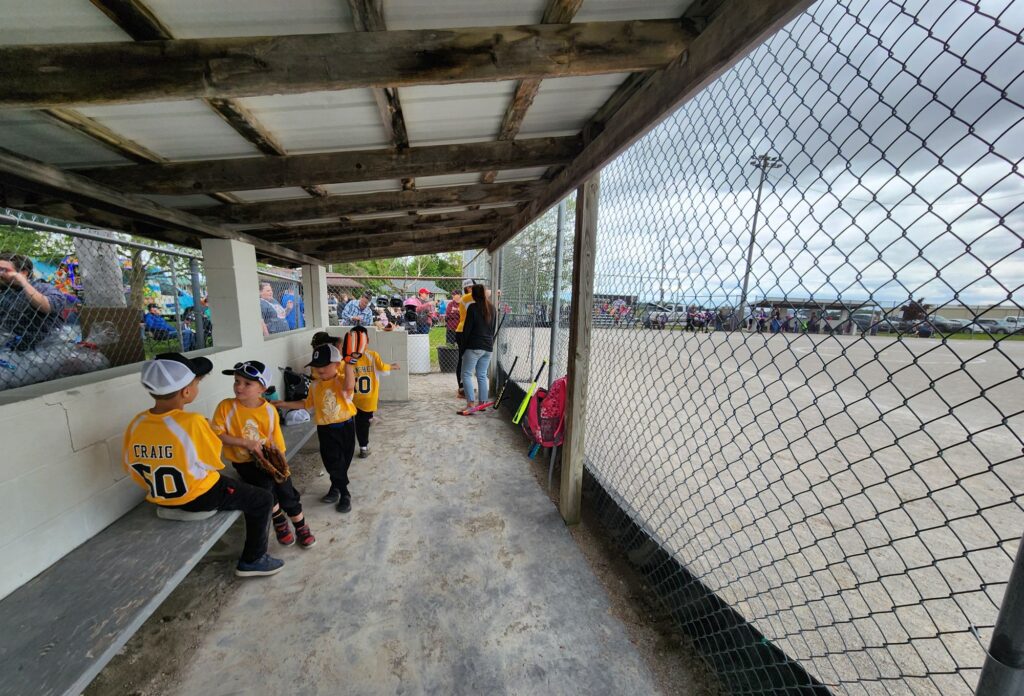
The Kosicki T-ball team loaded into one dugout, with the adults trying to keep the youngsters matched with their hats and gloves, and away from the bats. “Stop hitting things with the bat,” one adult said.
“This is part of it – how we act in the dugout matters,” a coach said to the players bubbling over with energy.
Once on the field, many of the lessons were forgotten. One player threw the bat with every swing at the ball. Other players forgot to run to base once they made contact with the ball. And infielders en masse immediately swarmed and smothered any ball hit in their direction.
By the end of the season, the games will most likely look different as the players perfect some skills. But some things won’t change. The fans will still cheer from the bleachers. The concession stand will still crank out buttered popcorn. And the children will remember another summer spent at the ballfield.
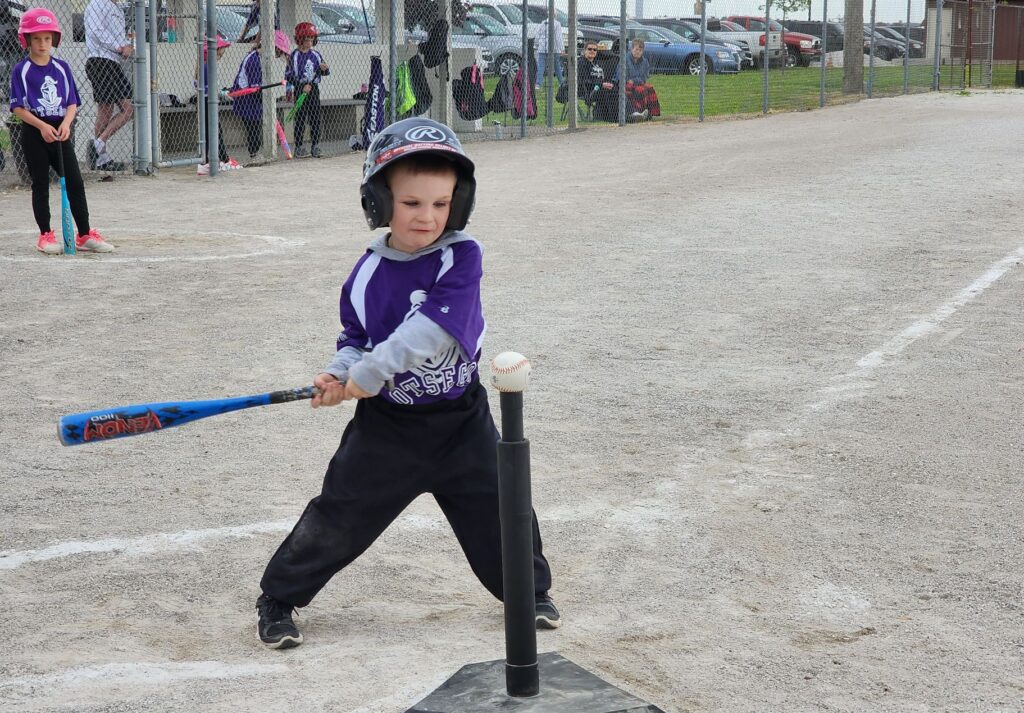
Rec Sports
Local swimmers learn from USA Olympic medalist Cody Miller
WATERVILLE, Maine (WABI) – Cody Miller won the gold medal in the 4×100 meter medley relay and a bronze in the 100 meter breaststroke at the 2016 Summer Olympics in Rio. He’s in Waterville this weekend to teach and inspire young swimmers. “I’m the lead clinician for the USA Swim Clinics, so I travel around […]

WATERVILLE, Maine (WABI) – Cody Miller won the gold medal in the 4×100 meter medley relay and a bronze in the 100 meter breaststroke at the 2016 Summer Olympics in Rio.
He’s in Waterville this weekend to teach and inspire young swimmers.
“I’m the lead clinician for the USA Swim Clinics, so I travel around the country and spread the joy and love of swimming that I had as a little kid to young athletes everywhere. I have a YouTube channel where I teach people how to swim better and be better. One of my viewers sent me an email and said ‘we’d love to bring you out to Maine.’ I was like, ‘yeah, sounds like fun,’ so here I am. I just try to make it as fun as possible. Swimming, and all sports, should be fun. If they’re not having fun, they’re not going to enjoy it, and then they’re not going to remember the things that you say. When I give them a drill or something, I try to make it fun and challenging in a way that stimulates the kids. Keep it exciting, keep it fun because swimming can be monotonous (lap and lap and lap). That’s not how I do things. It should be fun,” said Miller.
It’s a unique opportunity for local talent to learn from Miller.
“You don’t get a lot of chances to swim with an Olympic swimmer. They know all of those tips and secret things that a lot of people don’t know. It’s really inspiring. It’s awesome,” said Max Lichman-Paul, swimmer.
“I think it’s very impactful for the younger kids because they are like, ‘wow, this guy’s older. This guy knows what he’s talking about.’ So, it will be more likely for them to listen. It was such an inspirational moment for me when I was younger. I met two famous Olympians when I was younger as well. It was one of the greatest moments of my life. I loved taking pictures with them, getting things signed from them, and it was just really fun all around,” said Hayden Averill, event helper.
Miller discussed why he wants to teach the sport after his international success in the pool.
“I was lucky that I had a lot of great mentors and coaches that helped mold and shape me into the person that I am now. I owe that all to swimming because I gained all those mentors and awesome figures in my life from the sport of swimming. For me, it’s a way to give back to the next generation of athletes. It’s really fun, and it’s really rewarding,” said Miller.
Miller has won seven medals at the Olympics and World Championships in his career.
The clinic runs through Saturday.
Copyright 2025 WABI. All rights reserved.
Rec Sports
Youth sports leaders have mixed reactions to new $65 million Rochester sports complex – Post Bulletin
ROCHESTER — There have been many unanswered questions when it comes to the new Rochester Sports and Recreation Complex coming to the city’s southeastern side. Who will use it? Who does this benefit? Will it make money? One thing is clear: There is an opportunity to make Rochester a go-to destination for youth softball and […]
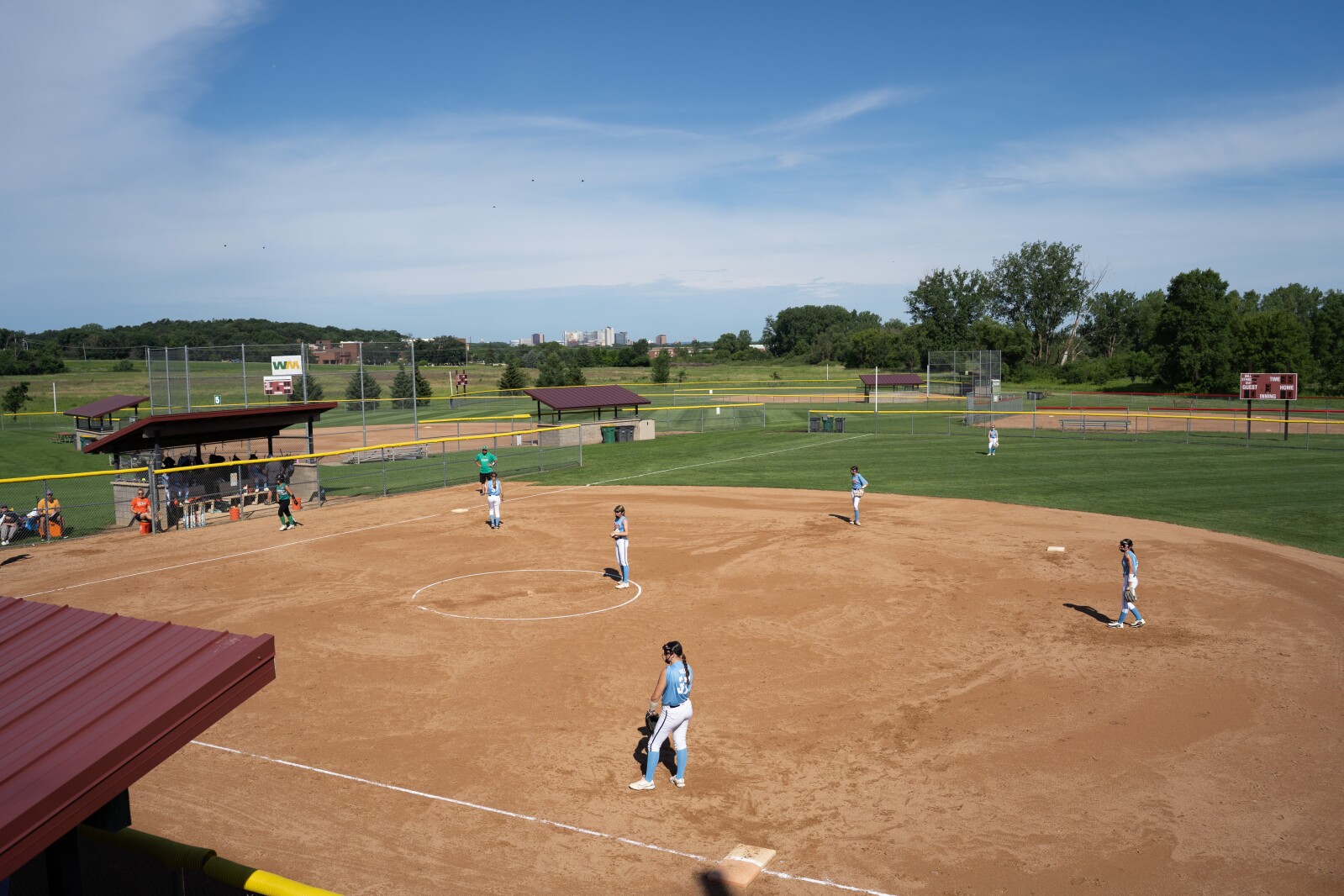
ROCHESTER — There have been many unanswered questions when it comes to the new Rochester Sports and Recreation Complex coming to the city’s southeastern side.
Who will use it? Who does this benefit? Will it make money?
One thing is clear: There is an opportunity to make Rochester a go-to destination for youth softball and baseball tournaments.
The Rochester City Council approved the schematic designs of the outdoor components of the project on Monday, July 7,
which are expected to require most of the $65 million available through
the $205 million extension of the city’s half-cent sales tax in 2023.
It calls for the building of eight all-turf ball diamonds with lights designed with flexibility for softball or baseball. Two rectangular turf fields, for soccer and lacrosse, and 12 pickleball courts will be built as well.
The complex will truly be one of a kind in regard to softball.
“There’s not another turf complex in Minnesota that can host that many games,” said Sean Hall, Forest Lake High School head coach and owner of S&C Sports Services. “We’ve been trying to get that up here in the (Twin) Cities.
“I’d love to be a part of running a tournament or two out there. Maybe one in the fall, one in the summer, if they are looking for people.”
Hall and S&C Sports have been running tournaments year-round across the Midwest for years. They recently hosted a softball tournament in mid-June in Lakeville that featured 205 teams, with 40% of those teams from out of state.
Rochester will soon have the ability to host similar-sized tournaments, when McQuillan Fields (seven diamonds) and the Rochester Youth Softball Complex (six diamonds) are factored in.
“The economic impact for the community would be huge if you get the big tournaments in. If you can get someone that can bring in a large number of teams, the economic impact on the community is great,” Hall said. “The city is going to be the one that’s going to benefit.”
That’s why plans for the complex have been altered since the initial renderings were released two years ago.

Contibuted / City of Rochester
The
initial four options presented in July 2023
called for an outdoor complex with eight to 12 multipurpose fields that could be used for soccer, lacrosse and football, along with other activities. With a major need for fields, the soccer community was originally all for that plan.
“How it was thrown out there at the beginning, I would have thought would have been perfect,” Minnesota Rush Executive Director Kevin Lowery Sr. said. “We definitely need a game/practice complex. The fields are in terrible shape. It’s nobody’s fault. It’s not Park and Rec’s fault, nobody’s fault. It’s just overuse. We just have too many people playing, and so it’s too bad that they switched over to baseball, softball.
“They switched because, for some reason, the city has turned into a for-profit company now where they need to make money, and it’s too bad. So yeah, we kind of got hoodwinked. We got shafted a little bit on this, this whole thing.”
Minnesota Rush runs youth soccer teams and leagues in Rochester, Winona, Albert Lea and New Prague. The group also offers travel/development teams and has adult leagues. According to Lowery, it’s the largest soccer group in the state.
That’s where the frustration lies, as Lowery and Minnesota Rush urged their 7,000 members to vote yes for the complex. In the end, 53.0% of people voted in favor of the half-cent sales tax extension.
“We were asked to push it, get it out to our 7,000(-person) membership to support the sales tax, because it was rectangle fields,” Lowery said. “I’m like, ‘Yep, we can do that.’ … We pushed it. I believe a lot of our membership went out to support it, and then all of a sudden, now we’re doing baseball and softball. It’s only two rectangle fields, the reasoning that we were told — and I totally agree with them, and I brought this up to them (at the) beginning — (is) they wanted to make this kind of a regional tournament destination.”
No city or area in the Midwest can compete in soccer with Blaine and its 40-field complex at the National Sports Center. Blaine is gearing up for the USA Cup, which features more than 1,000 teams from across the country and internationally.
Attempting to compete with the complex in Blaine is something Lowery voiced his concerns about initially, but it didn’t seem to hit home with project leaders until after the vote took place.
That was the reason for the switch to baseball/softball diamonds.
“… We aren’t going to be able to compete with Blaine,” said Rochester Sports Executive Director Matt Esau. “There’s some soccer people that aren’t real happy, but the fact of the matter is, with this, we have a lot more opportunity (with softball and baseball) and it’s more unique to our area.”
Softball participation numbers have grown in Rochester in the last five years, especially with the introduction of the 6U T-ball program. More and more girls are getting the opportunity to play at an early age. A facility like the soon-to-be-built complex could be a game-changer.
Rochester Youth Fastpitch Association President Ken Nance said the opportunity to have a “state-of-the-art” facility could mean big things for their club program, including relieving some pressure on the number of available fields in Rochester.
“There’s a tournament out in Mankato that draws hundreds and hundreds of teams. The best of the best. We’ve always wondered why we don’t have something like that in Rochester,” Nance said.
He said the Rochester Sports and RYFSA have had “meetings on meetings trying to figure out how to bring something like that to Rochester. I think this facility will get it done.”
Nance said the thought process is also to give both youth baseball and softball access to the complex during the week.
The hope is to bring college showcases as well, while the high school teams and RCTC softball are also expected to play on it, especially early in the season. The turf will allow use of the fields earlier and later in the season.

Sophia Marschall / Post Bulletin
“It’s a great thing for softball,” said Kim Jones, who coaches high school softball in Pine Island and coaches the Minnesota Stix 16U travel program for RYFSA. “You can bring more tournaments here and get them in, because you’ve got the turf, because even though it rains, as long as it’s not pouring down in the moment, you’re probably going to get your games in. Then you add the lights on top of that, you can really get things in. In the spring, you could potentially have northern teams coming down here and doing tournaments earlier on. Or the colleges, that could be another option for them to come play on instead of having to do everything inside the dome.”
Perhaps there could be potential to host the MSHSL softball state tournament. Rochester has precedent when it comes to hosting state tournament games, having hosted state football quarterfinals in the past.
Could this potentially lead to Rochester getting a Northwoods League softball team as well? Rochester has been rumored to receive a team since the inception of the league two years ago.
With the plan to have a “championship-specific” field — one that calls for extra seating with bucket seats — the possibilities seem endless when it comes to softball.
“I think it would give us an opportunity to expand even more because it’ll bring people in,” said Lake City standout Kylie Mann, who had played for the Minnesota Stix, along with other travel teams. “Having these new facilities, it’s kind of like, ‘Oh, if you practice at a cool place, you must be really good.’ So just having that atmosphere is like a pressure-builder of you wanting to do good and represent. I like to play on turf — all my teammates do. So having a big stadium close by, not just these random park fields, is cool.”
There are still questions regarding details such as concession money — the largest money-maker for the RYFSA — the rental fees and who is going to run the facility. All these questions will eventually be answered as the construction of the complex nears completion.
But an example of a quality sports complex dedicated to a sport is right here in Rochester. The National Volleyball Center at Century High School has been a success on a number of levels and offers a potential blueprint for the new complex.
“When you have anything new, or costing a certain amount of money, we all kind of go, ‘eh, what?'” Jones said. “But look at the volleyball center. They utilize that thing all the time. I think that’s been a huge payoff for the community.”
This article is the second in the Post Bulletin’s three-part series “Game Changer,” looking at the soon-to-be constructed Rochester Sports and Recreation Complex:
• July 5:
Will Rochester get its money’s worth with $65 million sports complex?
• Today: Softball, soccer stakeholders have differing reactions to $65 million complex
• July 19: How can adult rec leagues, athletes make use of new sports complex?
Rec Sports
Let Your Kid Climb That Tree
A bunny, small enough to nestle in a cereal bowl, has recently started hanging out in my backyard. Now and again, it nibbles a plant or lies in the sun. Mostly, it explores the limits of movement, zooming, darting, feinting, and trundling through bushes. Once, I saw it corner so hard that it sprayed mulch […]

A bunny, small enough to nestle in a cereal bowl, has recently started hanging out in my backyard. Now and again, it nibbles a plant or lies in the sun. Mostly, it explores the limits of movement, zooming, darting, feinting, and trundling through bushes. Once, I saw it corner so hard that it sprayed mulch in a giant, messy arc. A human kid who did that would almost certainly be called inside to clean up. But I haven’t seen the adults in this bunny’s life in weeks; the baby has carte blanche. If only more of the kids I know could be so lucky.
Wild animals are the best movers on the planet, and little ones spend much of their time frolicking, fighting, leaping, and climbing. From birth, human children share animals’ potential for wild movement; left to their own devices, they would presumably tumble about like puppies. But more and more, they do nothing of the sort.
This is due in part to the human trend toward self-domestication, and also to the structure of modern society. The World Health Organization says that 81 percent of adolescents worldwide do not get enough physical activity, noting that rates of sedentary behavior in young people tend to rise as their country develops economically. In some American cities, the Trust for Public Land says, as many as two-thirds of children lack access to the kinds of nearby parks that would encourage free play. And a report by the Aspen Institute’s Project Play initiative, a national program aimed at increasing youth-sports participation, concluded that compared with other activities, such as organized sports, “free play is all but a thing of the past.”
Some kids lack access to woods, fields, and other open spaces where they might romp free. Some have parents who forbid that brand of tomfoolery. In the United States, many parents habitually tamp down on horseplay out of fear of injury to their children (or their furniture)—or because social norms dictate that they get their squiggly kids unsquiggled and into waiting rooms, subways, stores, airplanes, and restaurants, where children are expected to “behave.” That impulse, however, risks reinforcing the notion that sedentariness is preferable at a time in a kid’s life when they really do need to move.
Turn over almost any rock in the stream of health research, and you’ll find warnings about the dire consequences of idleness, as well as abundant reasons for children to explore free movement. Children who move have healthier bones, muscles, and joints, and lower their future risk of obesity and chronic disease. Research has found that active kids develop superior cognitive skills, get better grades, and are more likely to stay on task than kids who are less active. In a systematic review of studies, researchers found that active children are more likely to report feelings of well-being. And a study published in The Lancet that examined the prevalence of adolescent depression among English youth suggested that increased sedentary behavior in adolescence could affect a person’s mental health into adulthood.
Childhood might be a particularly costly time to not move, because this is when developing brains prune unused potential. “One extreme view” of this neurological dwindling “would be that you start out wired up for every possible contingency,” the Harvard neuroscientist Jeff Lichtman said in an article in Proceedings of the National Academy of Sciences—but as you age, unused connections in the brain get permanently disconnected through a process known as synaptic pruning, leaving you with “a narrower nervous system.” We’re used to the idea that young, plastic brains have an easy time learning to speak Mandarin or play piano; this is also true of learning how to do backflips, balance on a slackline, or throw a fastball.
Parents go to great lengths to keep kids safe; it’s the core of the job. But restricting kids from encountering tricky movement problems, such as racing at full speed down a rocky slope or climbing high in a tree, can exact a toll. As Marcus Elliott, a physician and one of the world’s most prominent injury-prevention experts, put it to me: “Your fear that your kid will get hurt is depriving them of something they’ll never get back.”
Elliott runs the Peak Performance Project, known as P3, a movement lab in Santa Barbara, California, where many athletes—a huge percentage of NBA, NFL, and MLB players—have been found to be at risk of injury because of deficiencies in their movement quality. P3’s researchers focus on “kinematic movers,” whose bodies have a ready solution to almost any movement problem: They can land on either one foot or two, jump every which way, and change directions easily. They’re not always the highest jumpers or the fastest sprinters, but, at least among a well-studied cohort, they are likely to play for a long time without injury.
This is why Elliott recommends that children play like animals: He suspects that every adult kinematic mover grew up playing freely like that fuzzball in my backyard. The robustness necessary to repel injury has little to do with getting in cardio, running fast, or jumping high. Instead, he says, robustness has to do with “movement quality,” which is to athleticism as fluency is to language.
This tracks with an observation made by the journalist David Epstein, who writes in Range: Why Generalists Triumph in a Specialized World that athletes from tiny towns have irrational levels of success. Epstein’s theory is that with a shortage of players, small towns need the best athletes on the football, baseball, and basketball teams. Playing a variety of sports might foster a person’s robust movement vocabularies.
Thankfully, providing kids with more freedom doesn’t require a lot of money. Mostly, it just requires a little creativity.
Almost every kid who comes into my house feels a deep urge to romp on the huge yoga ball in our living room (which cost less than $20). They body slam it, Superman across its top, throw a sibling into it, and do other bonkers stuff. Many parents who witness such behavior grow anxious, shout bossy directives, or declare the ball off-limits entirely. Of course, I understand; no one wants to end up at urgent care. But I’m also aware that kids who start out falling down go on to quickly develop new skills. Some blossom into pro-grade yoga-ball surfers. When my son was young, he developed an uncanny ability to perch on all fours atop the ball even as someone (honestly: me) forcibly shoved him this way and that. He’s now a 6-foot-1-inch engineering undergrad; we have not outgrown this game.
Elliott told me that when work would keep him on the laptop during weekend afternoons, he’d give his kids small physical challenges: Can you hop on your left leg all the way across here, and then clear that hurdle? Can you step off that ledge, land, and leap right back up? One of his daughters remembers earning dessert by hopping a giant lap of the backyard on her left foot. Elliott and his children also wrestle one another like puppies do. In this way, he explained, his kids learn how to perform complex movements while keeping one another safe—by, say, avoiding the corner of the coffee table.
All of this free play can help when kids start taking up play of a more serious kind. Many sports injuries come from iffy form when landing. Kinematic movers do well, Elliott’s lab has found, because they land with active feet that greet the ground, as well as ankles, knees, and hips that flex nicely in time with one another—perhaps because these movers practiced so much free play as kids. P3’s trainers spend long hours putting athletes through the grueling work of mastering landing technique as teenagers or adults, remedial lessons that appear to have a big impact. A 2022 study found that ACL-injury-prevention training, which generally includes landing and explosive movement, reduced ACL tears by an average of 64 percent among young female athletes. (This aligns with research on ballet dancers, among the few groups who train from a young age to land properly. They may sustain plenty of sprains and other overuse injuries, but they also have a striking shortage of ACL tears compared with other athletes who jump as much.)
Eric Leidersdorf, a movement scientist and the president of P3, has more than a decade’s worth of experience poring over the movement data of elite athletes. He also has an 18-month-old daughter. I asked him if he intends to apply the lessons of his day job to parenting. “Absolutely,” he replied. He then used the word play 10 times in two minutes. “My real hope is that she explores the world,” Leidersdorf told me. “I want her to love moving and find joy in that.” I know a bunny that probably gets it.
When you buy a book using a link on this page, we receive a commission. Thank you for supporting The Atlantic.
Rec Sports
Childersburg Parks and Recreation fall sports registration nearing deadline
CHILDERSBURG, Ala. – Registration is wrapping up for fall youth sports with Childersburg Parks and Recreation. In-person sign-ups end Friday, July 11, at the R.S. Limbaugh Community Center for football cheerleading, tackle football, flag football and soccer. Online registration at childersburg.recdesk.com remains open through Saturday, July 12. Costs are $125 for cheerleading and tackle football, […]

CHILDERSBURG, Ala. – Registration is wrapping up for fall youth sports with Childersburg Parks and Recreation.
In-person sign-ups end Friday, July 11, at the R.S. Limbaugh Community Center for football cheerleading, tackle football, flag football and soccer.
Online registration at childersburg.recdesk.com remains open through Saturday, July 12.
Costs are $125 for cheerleading and tackle football, and $75 for flag football and soccer. Residents of the housing authority are eligible for discounted rates: $63 for cheer and tackle, and $38 for flag and soccer. Proof of residence is required at the time of in-person registration.
Officials encourage families to register now as spots are limited and deadlines are firm. For more information, visit the rec center or call Childersburg Parks and Recreation at (256) 378-6225.
Rec Sports
Kids enjoy Lew Mead Fishing Derby | News, Sports, Jobs
The grand prize award was captured by 5-year-old Joey Spayer who landed a whopping 15-1/2-inch smallmouth bass. Prizes provided by Evergreen Outfitters were awarded to the top eight youth participants. Submitted Photo Late June rainstorms delayed the 37th Annual Lew Mead Youth Fishing Derby at Cassadaga Lake on Saturday, June 28, and committee officials moved […]


The grand prize award was captured by 5-year-old Joey Spayer who landed a whopping 15-1/2-inch smallmouth bass. Prizes provided by Evergreen Outfitters were awarded to the top eight youth participants.
Submitted Photo
Late June rainstorms delayed the 37th Annual Lew Mead Youth Fishing Derby at Cassadaga Lake on Saturday, June 28, and committee officials moved the derby to Sunday, June 29. More than 40 kids from three to 16 years of age participated in discovering more about the outdoors through the fun of fishing. Prizes provided by Evergreen Outfitters (Mayville store) were awarded to the top eight youth participants. The grand prize award was captured by 5-year-old Joey Spayer who landed a whopping 15-1/2 inch smallmouth bass. All the kids received a souvenir Lew Mead Memorial hat, and t-shirt.
An annual fishing derby for kids that has continued for nearly 40 years offers a wealth of meaningful lessons for all to share. The continuity of the event reflects a strong, caring community.
When the kids of yesterday become the volunteers of today, the shared experiences foster long term bonds and a sense of responsibility to give back. Important lessons learned include traditions like the Lew Mead Memorial Derby by people who care.
Fishing teaches kids to slow down, observe, and appreciate the outdoors, qualities that are rare in our modern screen-driven world. They learn respect for wildlife, water and ecosystems, and they have a chance to observe the rhythms of nature. Kids learn that not everything in life is instant. Sometimes you wait. Sometimes you try and you fail. With fishing, you learn to keep trying. With fishing, kids learn to reinforce their focus, and they learn problem solving. Mentors say kids learn to be resilient thanks to fishing. Fishing contributes to something meaningful that can become part of a living tradition. Hats off to Derby chairman Steve Wickmark who said, “We are lucky to have a great supporting staff each year, thanks to them and the parents, all the kids had a great time.”
LAKE ERIE WALLEYE CONTEST THIS WEEKEND: The highly anticipated “Walleye Duel in Dunkirk” will take place on July 12 – 13, with the Captain’s Meeting to be held on Friday, June 11th, at 7:00 p.m. in the Clarion Hotel pavilion. Tournament Director, Mark Mohr, said,

More than 40 kids from 3 to 16 years of age participated in the 37th Annual Lew Mead Memorial Fishing Derby at Cassadaga Lake. All the kids received a souvenir Lew Mead Memorial hat, and T-shirt.
Submitted Photo
“This is an event not to be missed. Great prizes and fun for all.” Anyone interested in fishing in this tournament, please Mohr at 716-998-9871.
Outdoors Calendar
July 12-13: WALLEYE. Walleye Duel in Dunkirk, Dunkirk Pavilion – Clarion Hotel Pavilion, $500 entry; 3-fish bag/ 2-days; Captain’s Mtg on July 11; contact Mark Mohr: 716-998-9871.
July 17-20: WALLEYE. Sunset Bay Walleye Shoot-Out 2025, $500 entry, $750K prizes; 6-fish bag/day – 1-day major contest; Don Ruppert; 716-435-4137, visit: www.walleyeshootout.com/.
July 20: BASS. Chautauqua Lake Bassmasters 2025 Summer Open, Bass for Cash, 6 a.m. – 2 p.m., Prendergast Boat Launch, $200 Entry includes Big Bass Payout. Info: 716-708-0330.

Submitted photo
July 26-27: ARCHERY. NYS Archery Shooters Association (ASA) Federation Championship, Bear Lake Rod & Gun. Info: Rudy Abersold, 716-397-9717.
-
The grand prize award was captured by 5-year-old Joey Spayer who landed a whopping 15-1/2-inch smallmouth bass. Prizes provided by Evergreen Outfitters were awarded to the top eight youth participants.
Submitted Photo
-
More than 40 kids from 3 to 16 years of age participated in the 37th Annual Lew Mead Memorial Fishing Derby at Cassadaga Lake. All the kids received a souvenir Lew Mead Memorial hat, and T-shirt.
Submitted Photo
- Submitted photo
Rec Sports
‘The voice of youth sports’: Taggart Park baseball field named after John Lipez following recent upgrades | News, Sports, Jobs
HUNTER SMITH/THE EXPRESS John Lipez cuts the ceremonial ribbon, marking the dedication of Taggart Park field in his name during a ceremony on Friday morning. LOCK HAVEN — Youth baseball has been a staple for Clinton County for decades. Many youngsters have spent their summers practicing on a variety of fields within the City of […]

HUNTER SMITH/THE EXPRESS
John Lipez cuts the ceremonial ribbon, marking the dedication of Taggart Park field in his name during a ceremony on Friday morning.
LOCK HAVEN — Youth baseball has been a staple for Clinton County for decades.
Many youngsters have spent their summers practicing on a variety of fields within the City of Lock Haven and beyond — in particular Taggart Park.
Recently, the city upgraded the field along Park Street to continue being a key part of many childhoods for years to come.
With the history of this park in mind, city council along with its staff decided to dedicate the field to a longtime supporter of youth sports — John Lipez.
“For the past several decades, if you ask people who is the voice of youth sports in our area, they will inevitably say ‘John Lipez,’” Mayor Joel Long said during a ribbon cutting ceremony on Friday afternoon. “His voice, photos and writing have covered our local teams in victory and defeat, whether on the t-ball field or on the university wrestling mat — John has been a part of nearly every sporting event in our area that people value.”

HUNTER SMITH/THE EXPRESS
Attendees of the Taggart Park field dedication enjoy hotdogs provided by The Old Corner Bar & Grille following the ceremony.
This includes many Little League games which took place at Taggart Park.
Lipez, who hadn’t known about the honor until arriving at the field to see many members of his family, stood with Long as city staff unveiled the sign bearing his name.
“John’s legacy is not just about celebrating the wins, but calling out the exceptions, even in defeat,” Long continued. “His reporting is personalized, highlighting those who gave it their all, whether they win or lose.”
“It’s giving it a try, putting in the effort, that John has always celebrated. That’s what makes him an exceptional voice for youth sports in our community,” Long continued.
He noted John’s decades of support with promoting youth sports with his coverage and the time he spent coaching Little League, junior league and legion baseball.

HUNTER SMITH/THE EXPRESS
John Lipez, left, and Lock Haven City Mayor Joel Long, right, are pictured after Long announced Taggart Park field would be named in Lipez’s honor during a ceremony on Friday morning.
Lipez, who prior the announcement provided a history of the field — including his time playing baseball at 13 — joked that this “brings it full circle from 13 to whatever age I am now.”
He thanked city council, its staff, his family and everyone who was involved in the honor.
Prior to the surprise, Lipez offered a history of the junior league field, which was created in 1958.
Following this, he shared some anecdotes and memories.
“I told City Manager Greg Wilson I had 479 anecdotes to share about events at the new junior league field. He thought that might be overkill so I’ll offer a few,” he joked.
This included learning the strength of the late Bud Yost’s — a former Lock Haven Mayor and Clinton County Commissioner — are strengths when he was able to throw a ball from centerfield which went over the backstop and “was last seen rolling down Park Street towards St. Agnes.”
Another was when legendary Lock Haven High School football coach, the late Don Malinak, umpired for junior league in the 1950s.
He said during a game in 1958, a rival team player, Bud Neyhart, attempted to catch a high popup at first base.
“Unfortunately, it came down and struck him in the nose, causing considerable bloodshed. Umpire Malinak, always hard nosed, came to check on the player, grabbed his nose and said ‘yep, it’s broken,’” Lipez recalled.
Lipez also shared his own memories from the field. This included the 1959 Rotary Championship game, later his first American Legion homerun over the right field fence and coaching his son, Jeb, in Junior League.
“It was also the site of his first Lock Haven High School homerun over center field,” he said.
“What we have here today, 68 years later, is the next phase of the junior league history for the next generation to create its own memories,” he said.
Lipez pointed to his great grandson, Hudson, who was playing in the shade of a tree behind him. Hudson was turning three years old over the weekend, he said.
“I’d love nothing more than to see, in a decade, him playing first base on this very same field as did his great-grandfather and his great-uncle,” he said.
“Baseball has always been special in this community and in this country, creating memories that we all cherish,” he continued. “Thanks to all those involved for creating the Lock Haven Junior League field in 1958 and improving it even more in 2025.”
The improvements to Taggart Park and its field — funded through the city, the Department of Economic Development and Department Conservation and Natural Resources — included new dugouts, batting cage and walking path and renovations to the restrooms and were completed in 2024.
-

 Technology2 weeks ago
Technology2 weeks agoPet fitness and wellness trends for a healthier and happier dog
-

 College Sports2 weeks ago
College Sports2 weeks agoWAC to Rebrand to UAC, Add Five New Members in 2026
-

 Motorsports2 weeks ago
Motorsports2 weeks agoWhy Cosmetics are Making Up for Lost Time in Women’s Sports
-

 College Sports2 weeks ago
College Sports2 weeks agoA new era of Dickinson hockey begins behind the bench – The Dickinson Press
-

 Sports3 weeks ago
Sports3 weeks agoSEC Conference imposing a fine will create the opposite effect.
-

 Health2 weeks ago
Health2 weeks agoFlorida assault survivor shares hope for change with new mental health law
-

 Motorsports2 weeks ago
Motorsports2 weeks agoNASCAR This Week – Patriot Publishing LLC
-

 Motorsports1 week ago
Motorsports1 week agoTeam Penske names new leadership
-

 Youtube3 weeks ago
Youtube3 weeks agoFunniest MLB rain delay moments
-

 Sports2 weeks ago
Sports2 weeks agoHow to Market FAST Sports Content to New Audiences








 (Full inning!)
(Full inning!)



























